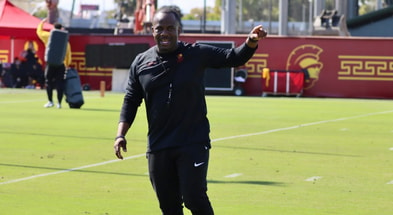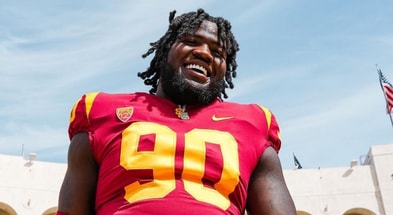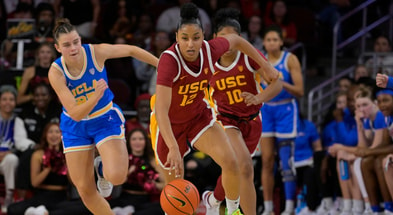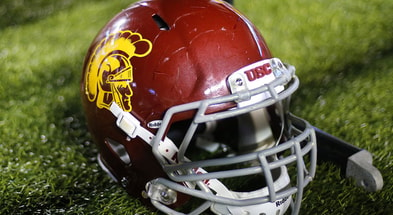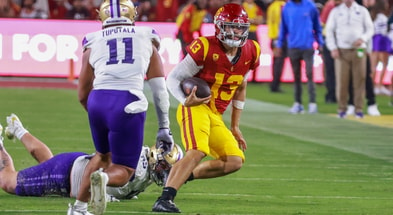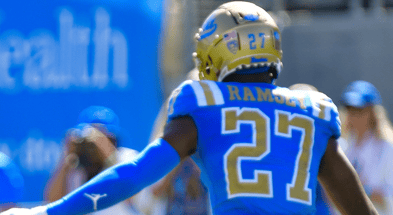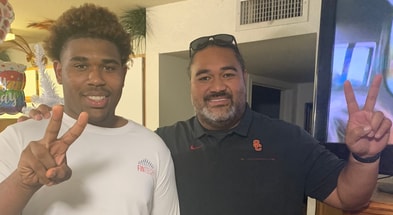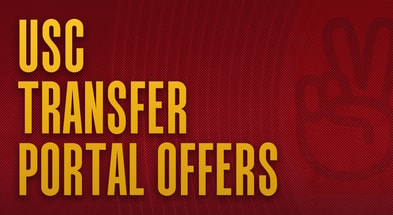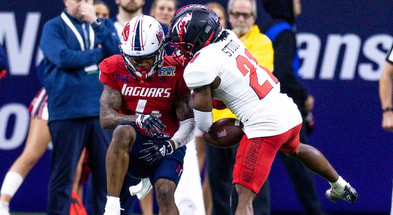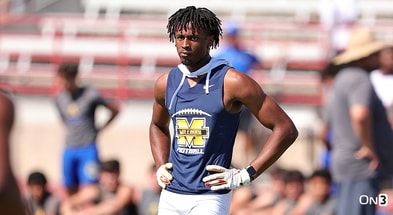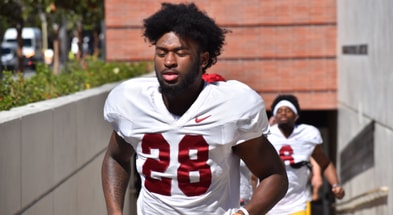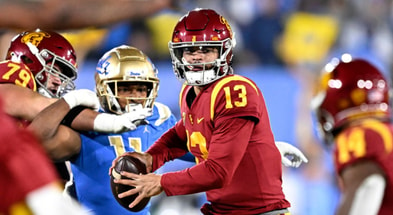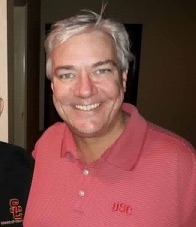An abrupt stop, and moving forward
And just like that, USC's 2020 football season is over. It felt like in one moment, the Trojans were poised to make yet another dramatic comeback late in the Pac-12 Championship Game. The next, the game was over, green and gold confetti shot into the air, and we unknowingly watched the Trojans walk off the field for the final time of the 2020 season.
It was a season that seemed as though it would never start, and the USC players deserve a ton of credit for resuscitating a season that was postponed and certainly seemed likely to be canceled completely.
They also deserve credit for delivering a handful of truly memorable moments in a season of just six games.
Drake London's fourth-and-nine, game-winning touchdown catch against Arizona State. Vavae Malepeai's touchdown run to cap off a six-play game-winning touchdown drive against Arizona. Amon-Ra St. Brown's four touchdown receptions in one quarter against Washington State. Talanoa Hufanga's interceptions in four-straight games. And any number of plays from USC players in the phenomenal comeback win against UCLA -- from Drake London's catch-and-run touchdown to Gary Bryant's kickoff return, Tyler Vaughns going up and over two defensive backs and two fourth-down stops by Drake Jackson and Hunter Echols.
And everything USC did this year -- a 5-1 record, Pac-12 South champions and being in position to potentially complete a comeback against Oregon in the championship game -- should be taken in context against the backdrop of what the players, coaches and staff had to deal with this season. A season that, even at only six games, was undoubtedly the most emotionally draining three months of any of their athletic lives. It wasn't easy to simply take the field this season, and the Trojans did it six times in completely or mostly empty stadiums, at 9:00 am, on a Sunday, on a Friday, with a full roster, missing key players and with an entire position group not having practiced
But it's also a season that needs to be taken in context with last season, the season before that, the last decade, and the entire history of USC football. And in that sense this year can't possibly be considered a complete success.
There were successes, to be sure. Hufanga was a joy to watch. London might be the best offensive player in the Pac-12 conference. Tuli Tuipulotu showed that he is ready to play big minutes right now. The defense and special teams were unquestionably improved from last year. And this team brought energy and passion in a season where that wasn't easy to achieve, when every play was met by a trivial amount of piped in noise played over the absolute silence of an empty stadium.
But USC needed its offense to lift the team this season, as the defensive coaches put things in overdrive this fall to make up for a missed spring ball. It felt like all the ingredients were there. Kedon Slovis was back at quarterback as everybody moved into the second year of Graham Harrell's Air Raid offense, and the Trojans lost just three offensive starters from last year's team, with ready-made replacements seemingly available. Alijah Vera-Tucker opted back in to be the rock at left tackle and while the offensive line needed some shuffling, the final pieces were all veteran players with starting experience. Four running backs had the ability to play for any program in the conference, the tight end group was still talented, and the wide receiver position looked like it somehow might have even gotten better despite the loss of Michael Pittman.
And with all of that going for it, the USC offense wasn't even as good as it was in 2019, when it still managed to drive the Trojans to just eight wins. This season, USC scored just one point per game more than last year, but generated 38 fewer yards of offense, was worse in the red zone, worse at converting third downs and gained nearly a full yard per play fewer. In a year where head coach Clay Helton said the goal was to run for 160 yards per game to compliment an elite passing attack, the Trojans rushed for 97 yards per game, last in the conference and 30 yards per game fewer than the 11th-place team. USC's 3.2 yards per carry ranked 120th in the nation. And while the total passing yards were there, it was far from being the elite passing attack that Helton lumped in with last year's aerial displays from Alabama and LSU. USC led the conference in passing yards per game, but the Trojans were just sixth in yards per attempt and all way down in ninth when it came to yards per completion.
USC was much better when it came to turnovers this season, though ultimately it was three huge ones in the Pac-12 Championship Game that played a major role in the Trojans finishing their season with a loss. But penalties continue to plague USC. After finishing 11th in the conference in penalty yards last season, the Trojans were dead last in penalty yards per game this season, and there was some distance there, as the difference between 11th place and USC in last was about the same as first place to fourth place.
Helton and USC have to figure out what's going on with the offense. Slovis didn't look right for long stretches this season and he's already proven himself to be too talented to think that it's just a regression. Obviously there is now plenty of concern about his shoulder after that hit on the final player of the season, as well as whether a lingering injury could have been contributing to the way the ball was coming out of his hand at times this season. But the concern goes well past simply who is taking snaps from behind -- but never under -- center.
The running game is a mess, and it feels like there might be about 100 different factors at play there. Mike Leach at Mississippi State went all in this season on throwing the ball and the Bulldogs ran for 36 yards per game. It's a comically low number that gets far less funny when you realize that sitting there just seven spots higher is USC, at 97.3 yards per game.
In 19 games under Harrell, USC has produced a 100-yard rusher just three times. In six of those 19 games, the Trojans' leading rusher has been held below 50 yards. USC ran for 584 yards in six games this season. Ohio State ran for 399 in the Big Ten Championship Game alone.
Over the final four games of this season, USC averaged 2.1 yards per rush (including sack totals). In six games, USC faced 38 situations of either third or fourth down and three or fewer yards to go. The Trojans were successful running the ball for first downs on 12 occasions. Ten times they tried to run and were denied. Against UCLA, USC was phenomenal in those situation, converting seven of eight times, and doing it on the ground six times. But USC converted fewer than 50% of those opportunities against Arizona State, Arizona and Oregon.
Defensively, the Trojans took some steps forward. But with Hufanga likely leaving for the upcoming NFL Draft, you're reminded once again how short the college careers of some players can be. And the clock displaying Drake Jackson's time in cardinal and gold is now ticking a little louder. He produced a couple memorable plays this year, but also seemed to get a little lost in the defense at times, which can feel a little frustrating -- probably for everybody involved -- with a player as talented as he is. I do think the ingredients are there for success here, although the scheme is aggressive enough that there are likely going to be the occasional busts and plays where the offense has the perfect play called to take advantage of a blitz. But that tradeoff seems acceptable when it comes as part of a defense that the players truly enjoy playing and feel comfortable in.
Offensively, maybe missing spring ball was a huge deal. Offensive linemen were going to be in new spots from last season and maybe not getting that time together had a significant impact on the position this season. Maybe another year of nagging injuries at the running back position helped derail the running game. Whatever the issue, the trajectory on the side of the ball is not good. Outside of the first quarter against Washington State and most of the second half against UCLA, it never felt like the USC offense was really clicking the way it was expected to.
If the only two grades are success and failure, then you have to put this season into the latter category. But I think there's more nuance available than that. It's a season where really nobody in the Pac-12 should be doing much crowing about how many games they won or how they looked on the field. But this team found some off-the-field wins that will help them moving forward, and if the defensive coaches stay in tact and continue to impose themselves on the program, the Trojans can find some things to build on for next season.
But the question marks are numerous, and nearly blinding at this point. The offensive line will again come into the season as a work in progress, and that's not a unit you want to be talking about in that way year after year. Will Kedon Slovis be fully healthy and can any quarterback actually stay healthy in this offense? Are there enough playmakers on defense if Hufanga and Marlon Tuipulotu both declare for the draft? How amenable is this offense to running backs in general, and the ones on the roster specifically? Can the penalty issues be fixed by doing the same things that haven't fixed them so far? And if not, what can fix them?
I don't blame the program for making the decision to opt out of a bowl game. I'm not going to downplay how emotionally taxing this season has been on everybody in the program (and all programs in the conference) and the players being able to spend time with their families for the first time since September is an understandable factor that went into the decision.
But this season showed that USC isn't simply one game or a handful of plays away from where they want to be, if championships beyond the Pac-12 South truly are the goal. And giving Oregon the momentum of a second-straight Pac-12 Championship means the path leading back to the top of the conference just got that much steeper for USC.
